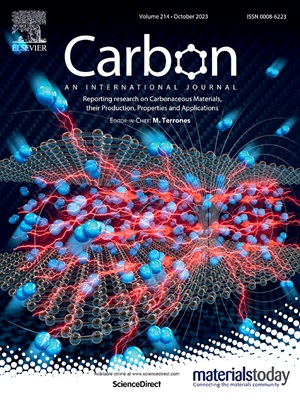采用量子点改性填料和电沉积铜改性碳纤维制备双向高导热CFRP复合材料
IF 11.6
2区 材料科学
Q1 CHEMISTRY, PHYSICAL
引用次数: 0
摘要
碳纤维增强聚合物(CFRP)复合材料具有低的通平面导热系数(TC <;0.6 W/(m∙K)),由于碳纤维(CFs)的定向排列和树脂的低TC,严重限制了实际应用。在树脂基体中加入填料和构建连续导热网络是提高导热系数的有效方法。然而,CF表面粗糙度低导致界面性能较差,且CF铆接点之间固有的间隔限制了通面TC的增强。双向高碳化钨复合材料的制备仍然是一个巨大的挑战。本文采用多层叠片和热压耦合法制备了碳点(CDs)改性膨胀石墨(EG)和cu改性CF的新型CDs-EG/EP-CF@Cu复合材料,其中利用EG构建三维导热网络,利用CDs改善EG-环氧树脂界面相容性,利用电沉积方法优化cu改性CF的界面并构建纳米级粗糙度。结果表明,CDs-EG/EP-CF@Cu复合材料具有较高的双向TC (8.75 W/(m∙K)平面内TC和36.97 W/(m∙K)平面内TC)。此外,我们的复合材料具有优异的热响应性,电导率(18320 S m−1),电磁干扰屏蔽(86.52 dB)和力学性能。本工作为制备双向高TC CFRP复合材料提供了一种新方法。本文章由计算机程序翻译,如有差异,请以英文原文为准。

A novel CFRP composite with bi-directional high thermal conductivity via quantum dots modified filler and electrodeposited Cu modified carbon fiber
Carbon fiber-reinforced polymer (CFRP) composite has low through-plane thermal conductivity (TC < 0.6 W/(m∙K)) due to the directional arrangement of carbon fibers (CFs) and low TC of resin, which seriously limits actual application. It is an effective method to improve TC by loading fillers and constructing continuous thermal conductive networks in the resin matrix. However, low surface roughness of CF causes poor interface performance, and inherent intervals among CF riveting points restrict the enhancement of through-plane TC. The preparation of CFRP composite with bi-directional high TC is still an enormous challenge. In this work, a novel CDs-EG/EP-CF@Cu composite with carbon dots (CDs) modified expanded graphite (EG) and Cu-modified CF is prepared by multilayer lamination and hot-pressing coupling method, where EG is utilized to construct 3D thermal conductive networks, CDs is employed to improve EG-epoxy interface compatibility and Cu-modified CF by electrodepositing is exploited to optimize the interface and construct nano-scale roughness. Results show that CDs-EG/EP-CF@Cu composite exhibits high bi-directional TC (8.75 W/(m∙K) through-plane TC and 36.97 W/(m∙K) in-plane TC). Besides, our composite exhibits excellent thermal responsiveness, electrical conductivity (18320 S m−1), electromagnetic interference shielding (86.52 dB), and mechanics properties. This work provides a novel method to prepare bi-directional high TC CFRP composites.
求助全文
通过发布文献求助,成功后即可免费获取论文全文。
去求助
来源期刊

Carbon
工程技术-材料科学:综合
CiteScore
20.80
自引率
7.30%
发文量
0
审稿时长
23 days
期刊介绍:
The journal Carbon is an international multidisciplinary forum for communicating scientific advances in the field of carbon materials. It reports new findings related to the formation, structure, properties, behaviors, and technological applications of carbons. Carbons are a broad class of ordered or disordered solid phases composed primarily of elemental carbon, including but not limited to carbon black, carbon fibers and filaments, carbon nanotubes, diamond and diamond-like carbon, fullerenes, glassy carbon, graphite, graphene, graphene-oxide, porous carbons, pyrolytic carbon, and other sp2 and non-sp2 hybridized carbon systems. Carbon is the companion title to the open access journal Carbon Trends. Relevant application areas for carbon materials include biology and medicine, catalysis, electronic, optoelectronic, spintronic, high-frequency, and photonic devices, energy storage and conversion systems, environmental applications and water treatment, smart materials and systems, and structural and thermal applications.
 求助内容:
求助内容: 应助结果提醒方式:
应助结果提醒方式:


